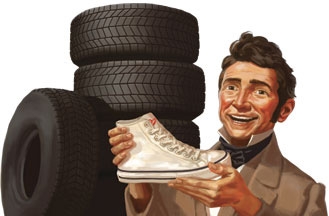
In the early 1800s, American businessmen caught the ‘rubber fever. They imported tonnes of rubber from Brazil, hoping to reap riches by turning it into baggage and life preservers. What they didn’t realise was that rubber turned into a sticky mess in summer and became hard and brittle in winter.
Charles Goodyear, whose hardware store went bankrupt in 1830, became interested in turning rubber into a usable material. He experimented by mixing it with various chemicals like nitric acid and sulphur, but with limited success. Once while trying to sell his sulphur-improved rubber at a hardware store, Goodyear became agitated when the owner mocked his product. He gesticulated wildly and the piece of rubber flew from his hand onto a hot, open stove top. While scraping it off, he found that it had become hard yet flexible!
After more experiments, Goodyear finally perfected the process. Called ‘vulcanised’ rubber (from the Roman god of fire, Vulcan), it created untold wealth for the many entrepreneurs who used Goodyear’s idea without his consent, even though he had a patent. Goodyear himself died in 1860 heavily in debt because of fighting and losing many court battles. Much later, his family benefited from the royalties earned from his patent.
Picture Credit : Google




